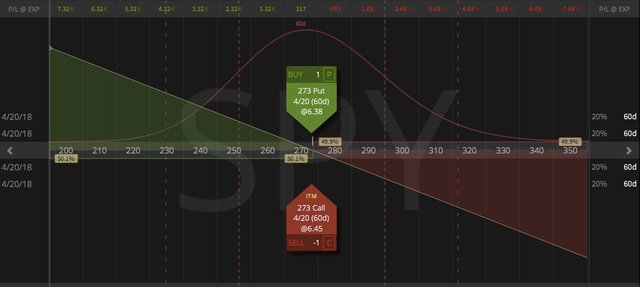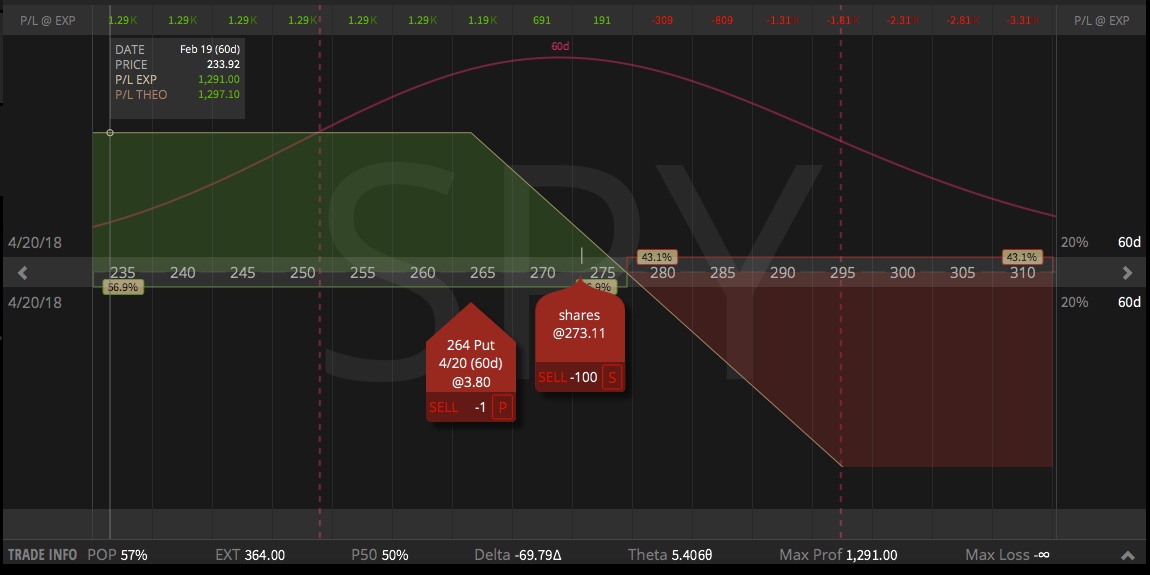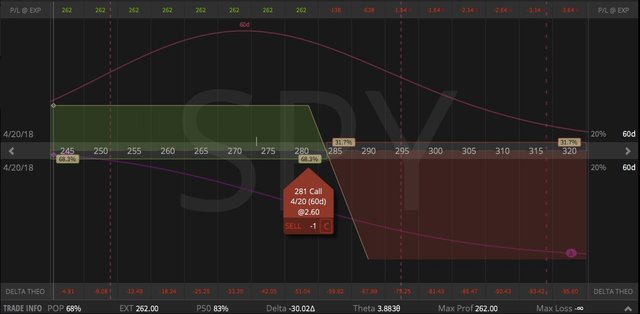Introduction into Options Trading Lesson 5
Hi Steemians,
in the previous four lessons, I taught you everything you need to know about options and I also talked about long stock, the synthetic long stock strategy, the covered call and the naked put and how to manage these strategies.
If you have missed the these four lessons of this course, you can read them here:
https://steemit.com/money/@stehaller/introduction-into-option-trading-lesson-1
https://steemit.com/money/@stehaller/introduction-into-option-trading-lesson-2
https://steemit.com/money/@stehaller/introduction-into-options-trading-lesson-3
https://steemit.com/money/@stehaller/introduction-into-options-trading-lesson-4
All the strategies, I talked about in the last lesson gave you long deltas.
Today I’m going to talk about strategies, which give you short deltas, so that you know how to profit from falling stock prices.
First let’s have a look at a short stock position:

Selling short shares of stock is a little bit hard to understand for beginners.
By selling short, you sell stocks, you do not own and your goal is to buy them back later at a lower price.
In the example above you sell short 100 shares of SPY at $273.11, so you collect $27,311.
Your margin requirement for this trade is 50% of the stock price ($13,656).
When the price of the stock moves, your margin requirement will change also.
Like being long shares of stock, selling short, is a pure directional play and a 50/50 shot.
You get 100 short deltas, so if SPY moves down by $1, you gain $100 and if SPY moves up by $1, you lose $100.
So let’s assume you sold short 100 shares of SPY at $273.11 and the price of SPY goes down to $263.11.
Now you buy to cover those 100 shares of SPY and have to pay $26,311.
Since you got paid $27,311 when you initiated the short sale, your profit is $1,000.
But how can you sell something you do not own, you might ask?
Well, you have to borrow these shares of stock.
Usually this is done internally. Your broker has virtually countless accounts with long stock positions. So if you want to sell short, your broker takes the shares from other accounts and lends them to you. Sometimes stocks are non to borrow, meaning your broker can’t lend you shares of stock of a certain company to sell short. If a stock is hard to borrow and you short it, there is always the risk, that your broker closes your position, when another customer wants to sell his long stock position.
Short stock is considered to be one of the riskiest strategies in the trading world, since the price of a stock can only go to zero, but there is no limit to the upside, so your losses can be unlimited. It is also important to know, that if a company pays a dividend and you are short the stock, you have to pay the dividend to the owner of the stock. So the dividend comes right out of your pocket.
Selling stocks short costs a lot of buying power, but there is a better way, which gives you virtually the same short position, but has a little bit higher probability of profit and costs much less in buying power.
The Synthetic Short

In order to create a synthetic short stock position, you sell to open an atm call and buy to open an atm put.
This only costs you $6,153 in buying power reduction, compared to over $13k for a short stock position. But this can although change, when the price of SPY moves up.
In this example it can be done for a credit of 17 cents. So your probability of profit is a little bit higher than 50%.
But don’t forget, the risk is the same like in a short stock position, since you also have 100 short deltas. Your risk is basically unlimited, since the price of SPY can go up unlimited and your max profit is $27,300, since SPY can only go to zero.
If there is a dividend payment, which happens every quarter in SPY, your short call is in danger of getting exercised and then you will end up with a short stock position and you will also have to pay the dividend. So like I told you in the last lesson, always check the extrinsic value of your short call (by looking at the price of the corresponding put) the day before the underlying stock goes ex dividend and if the extrinsic value of your short call is lower than the dividend, then you have to either close your position or roll to the next month.
Since I don’t like 50/50 shots, I’m going to show you other strategies, that also give you short deltas, but have a much higher probability of profit.
1. The Covered Put
The covered put is just the opposite of a covered call.
Buy selling a covered put, you sell short 100 shares of stock and sell a put against it.
As always, from a risk/reward standpoint, the 30 delta put is the best strike to use.
The ideal timeframe for your short put is 45 days until expiration (anything between 30 and 60 days is ok).
A covered put is a great strategy, when you are planing to hold on a short position for a longer time frame. By selling puts against your short stock, you can lower your basis price on your short stock position every month.
Let’s have a look at the P&L graph:

For the short sale of 100 shares of SPY you get paid $273.11 (times 100) and additionally you get paid $3.80 (times 100) for the 264 put.
So your break even price goes ups to $273.11 + $3.80 = $276.91.
Your probability of profit is 57% on this trade, you collect $5.40 in theta per day and your buying power reduction is roughly 50% of the stock price minus the put credit ($13,465.50).
Your max profit on this trade is $1,291 and your max loss is basically unlimited, since the price of SPY can go up unlimited.
This trade gives you about 70 short deltas. But this short deltas can grow to 100, if the price of SPY goes up.
How to manage this trade:
When you have reached 50% of max profit ($645.50) you either close the position (if you don’t want to be short anymore) or roll your put to the next expiration cycle and collect more credit.
You roll your put to the next month, by buying to close your short put and selling to open the new 30 delta put (or the same strike as the old one) in the next month, but do it only, if you can collect a net credit. Never roll if you have to pay a debit.
When you reach 21 days until expiration, always roll or close your position, to avoid gamma risk.
Defense:
If the price of the underlying stock goes against you (up), your short deltas grow. What was a 70 short delta position in the beginning, quickly becomes a short 100 delta position. To reduce your short deltas, you roll up your put to the new 30 delta.This way, you collect more credit and you have a higher chance to break even on this trade.
If you have still way more than 21 days until expiration, you stay in the same expiration cycle, if not, you roll out to the next month.
Dividend risk:
As I said before, if a company pays a dividend and you are short the stock, you have to pay the dividend to the owner of the stock. So the dividend comes right out of your pocket.
Basically this is no big deal, since when a stock goes ex dividend, the price of the stock moves down by the amount of the dividend paid. So you lose the dividend, which you have to pay, but your position gains the same amount, since the stock price moves down. If you don’t like to pay the dividend every quarter, you have to close the position the day before the stock goes ex dividend.
Assignment Risk:
If your short put is deep itm, you have to look at the corresponding call. If the corresponding call has basically no value left (around 5 cents or less), the risk of getting assigned is very high. In this case, try to roll out to the next month (buy to close your short front month put and sell a new one at the same strike in the next expiration cycle, but only if you can do it for a net credit). If you can’t roll for a credit, than you either wait until you get assigned or close the whole position (buy to close the put and buy to cover the short stock).
Getting assigned on a covered put is a high class problem, since the price of the stock did what you wanted, it went down.
Getting assigned on a short put leaves you with 100 shares of long stock, but since you already have 100 shares of short stock on, you end up with zero (-100 + 100 = 0).
The Greeks:
A covered put is a short delta, long theta, short gamma, short vega position.
You want the price of the underlying stock to go down and the implied volatility also to go down. This is unlikely to happen all at once. Usually when the price of the underlying stock goes down, implied volatility goes up. So if the price of the underlying stock goes down, your short put gets more expensive, but you make money on your short stock.
2. The Naked Short Call:
A naked short call is just the opposite of a naked short put.
It is a short delta position, so you make money if the price of the underlying stock moves down or doesn’t close beyond your break even on the upside at expiration.
Let’s have a look at the P&L graph:

Like always the strike price with a 30 delta is best from a risk/reward perspective and the ideal timeframe for your short call is 45 days until expiration (anything between 30 and 60 days is ok).
If you sell to open this SPY April 281 call you are obligated to deliver 100 shares of SPY, if the owner of the call exercises his call. So you can end up with a short stock position.
For taking this risk you get paid $2.60 (times 100 = $260) in premium and your margin requirement is $4,789 at the moment. Your margin requirement can grow, when the price of SPY moves up.
This short call gives you 30 short deltas. The pink line in the picture above shows you how your delta changes, when the price of SPY rises.
Your probability of profit is 68% and your probability of making 50% of max profit is 83%.
Since a short call is a short premium strategy, you get paid more when the IVR is high (above 50%).
The max profit on this trade is what you get paid for ($260) and you max loss can be unlimited, since the price of SPY can go up unlimited. Therefore a short call is considered to be one of the riskiest strategies in trading.
How to manage this trade:
You manage this trade at 50% of max profit ($260/2 = $130), so if your call trades only for $1.30, you buy it back. If you wanna keep a short position in this company or ETF, you immediately sell a new call at the new 30 delta in the next expiration cycle.
If you reach the point where there are only 21 days until expiration left, you either close your position or roll out to the next month (new 30 delta or same strike), but only if you can do it for a credit. This way, you avoid most of the gamma risk.
If you don’t want to end up with 100 short shares of the underlying stock, you also close the trade, if your losses have reached 2 times of the credit received.
In this example you would buy to close this short call, if it trades for $7.80.
If you want to be short the underlying stock, you just keep rolling, as long you can get a net credit. If you can’t get a net credit, since your call is too deep itm, you just wait until the call gets assigned and then you end up with 100 short shares of stock and immediately start selling the 30 delta put against it.
Assignment Risk:
If your short call is deep itm, you have to look at the corresponding put. If the corresponding put has basically no value left (around 5 cents or less), the risk of getting assigned is very high. In this case, try to roll out to the next month (buy to close your short front month call and sell a new one at the same strike in the next expiration cycle, but only if you can do it for a net credit). If you can’t roll for a credit, than you either wait until you get assigned (if you still like being short the stock) or close the position (buy to close).
Dividend risk:
If there is a dividend payment, which happens every quarter in SPY, your short call is in danger of getting exercised and then you will end up with a short stock position and you will also have to pay the dividend. So like I told you above, always check the extrinsic value of your short call the day before the underlying stock goes ex dividend and if the extrinsic value of your short call is lower than the dividend, then you have to either close your position or roll to the next month.
Defense:
If the price of the underlying stock goes against you (up) and your short call goes itm, your short deltas grow. What was a 30 delta call in the beginning, quickly becomes a 50, 70 or even 100 delta call. To reduce your short deltas, you can sell a put against your position (this won’t cost you more buying power). This way, you collect more credit and you have a higher chance to break even on this trade.
Of course, there is always the chance, that the underlying stock goes back down and blows through your short put. If this happens, you need to roll down the call in order to collect more premium and try to break even on the way.
Playing defense on a short call is harder than on a short put, since when stock prices go up, implied volatility goes down and options, especially puts get cheaper. So you get paid less for the put you sell against your call. But playing defense help you to reduce your losses or to break even on your position.
The Greeks:
A short call is a short delta, long theta, short gamma, short vega position.
So you want the price of the underlying stock to go down and/or the implied volatility to go down either. This usually doesn’t happen at the same time. Since when the price of the underlying stock goes down, implied volatility goes up. But your short deltas usually make up for the rise in implied volatility.
Again we covered a lot today.
You now know the most basic short options strategies for premium sellers.
The Covered Put and the Short Call.
If you liked this lesson, please upvote and resteem.
If you have any questions, feel free to ask.
In the next lesson, I’m going to show you defined risk long and short strategies, which cost much less in buying power, than naked strategies.
Have a wonderful day,
Stephan Haller
Well detailed thank you for writing this article UpVoting
Trading option sucks. You might be right in price prediction yet you end up loosing money.
Only if you buy naked options. But this series is about premium selling.